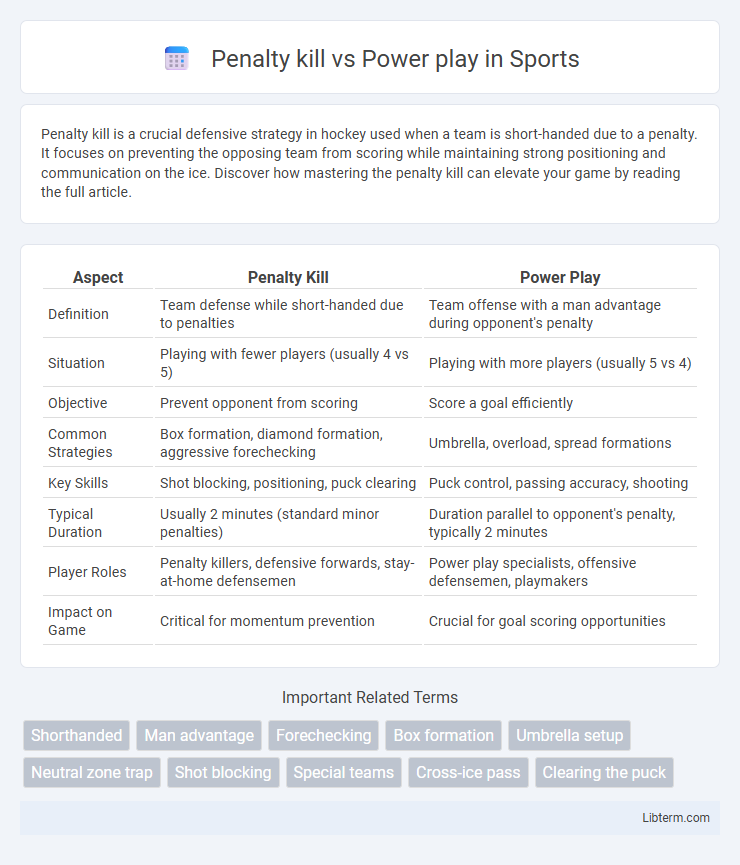Penalty kill is a crucial defensive strategy in hockey used when a team is short-handed due to a penalty. It focuses on preventing the opposing team from scoring while maintaining strong positioning and communication on the ice. Discover how mastering the penalty kill can elevate your game by reading the full article.
Table of Comparison
| Aspect | Penalty Kill | Power Play |
|---|---|---|
| Definition | Team defense while short-handed due to penalties | Team offense with a man advantage during opponent's penalty |
| Situation | Playing with fewer players (usually 4 vs 5) | Playing with more players (usually 5 vs 4) |
| Objective | Prevent opponent from scoring | Score a goal efficiently |
| Common Strategies | Box formation, diamond formation, aggressive forechecking | Umbrella, overload, spread formations |
| Key Skills | Shot blocking, positioning, puck clearing | Puck control, passing accuracy, shooting |
| Typical Duration | Usually 2 minutes (standard minor penalties) | Duration parallel to opponent's penalty, typically 2 minutes |
| Player Roles | Penalty killers, defensive forwards, stay-at-home defensemen | Power play specialists, offensive defensemen, playmakers |
| Impact on Game | Critical for momentum prevention | Crucial for goal scoring opportunities |
Understanding Penalty Kill and Power Play
Penalty kill and power play are critical special teams strategies in ice hockey that directly influence team performance during penalties. Penalty kill refers to the defensive effort by a team when they are short-handed due to a player serving a penalty, aiming to prevent the opposing team's power play from scoring. Power play occurs when a team has a numerical advantage on the ice as the opposing team serves a penalty, focusing on creating scoring opportunities and capitalizing on their extra player.
Core Objectives: Penalty Kill vs Power Play
The core objective of the penalty kill is to prevent the opposing team from scoring while shorthanded by effectively clearing the puck and maintaining tight defensive positioning. In contrast, the power play's primary goal is to capitalize on the numerical advantage by creating high-quality scoring opportunities through precise puck movement and strategic positioning. Each strategy relies on coordinated teamwork and situational awareness to control game momentum and influence scoring outcomes.
Key Strategies in Power Play Situations
In power play situations, key strategies include maintaining puck control through precise passing and effective positioning to create shooting lanes, maximizing scoring opportunities by exploiting defensive weaknesses. Utilizing formations such as the umbrella or overload enhances puck movement and pressure on the penalty-killing unit. Effective power play units also prioritize quick puck retrievals and coordinated player movements to sustain offensive zone time and generate high-quality scoring chances.
Essential Tactics for an Effective Penalty Kill
Effective penalty kill tactics emphasize aggressive shot blocking, strategic positioning, and tight gap control to limit the opposing power play's scoring chances. Defensive units prioritize collapsing around the net to protect the high-danger areas while coordinating seamless passing lane disruptions and clearing attempts. Communication and quick decision-making remain crucial for effectively disrupting puck movement and forcing low-percentage shots.
Player Roles and Responsibilities
Penalty kill units emphasize defensive positioning, with forwards tasked to tightly mark opposing power play players and disrupt passing lanes, while defensemen clear the front of the net and block shots. Power play players focus on puck control and creating scoring opportunities, with the quarterback managing power play setup and shooters positioned for optimal shot angles. Both units require strong communication and anticipation to anticipate opponent moves and maintain strategic advantage.
Special Teams Formations Explained
Penalty kill and power play formations are critical components of special teams strategy in hockey. The penalty kill formation typically employs a box or diamond setup designed to protect the slot area and limit high-danger scoring chances while shorthanded. Power play formations often use umbrella, overload, or 1-3-1 structures to create space, move the puck efficiently, and generate shots from high-percentage areas such as the point and the crease.
Statistical Analysis: Success Rates in NHL
Penalty kill success rates in the NHL typically range between 75% and 85%, reflecting the defensive team's ability to prevent goals while short-handed. Power play efficiency varies more widely but generally averages around 20% to 25%, indicating the percentage of opportunities that result in goals scored by the attacking team. Statistical analysis reveals that teams with higher penalty kill percentages often excel in blocking shots and maintaining disciplined positioning, while successful power plays rely heavily on puck possession and shot quality metrics.
Famous Moments: Power Play and Penalty Kill Highlights
Famous moments in NHL history highlight the intensity of power play and penalty kill situations, such as the New York Rangers' iconic 1994 Stanley Cup run where their penalty kill consistently stifled opponents. The 2010 Winter Classic showcased the Boston Bruins executing a flawless penalty kill, turning defense into offense with critical shorthanded goals. Legendary players like Mario Lemieux and Wayne Gretzky have defined power play excellence, scoring pivotal goals that shifted momentum and secured victories during crucial playoff games.
Training Drills for Power Play Excellence
Effective training drills for power play excellence focus on puck movement, positioning, and quick decision-making under pressure to maximize scoring opportunities with a man advantage. Drills such as rapid perimeter passes, shooting from one-timers, and creating passing lanes simulate game-like scenarios that improve timing and player synchronization. Emphasizing communication, zone entry strategies, and net-front presence during practice sessions enhances the team's ability to capitalize on power play situations efficiently.
Improving Penalty Kill Efficiency
Enhancing penalty kill efficiency relies on effective positioning, quick puck retrieval, and aggressive shot blocking to limit the opponent's power play opportunities. Teams that consistently communicate and maintain tight defensive formations reduce high-danger scoring chances during shorthanded situations. Incorporating video analysis and practicing clear zone exits enable penalty killers to transition swiftly from defense to offense, improving overall kill success rates.
Penalty kill Infographic

 libterm.com
libterm.com